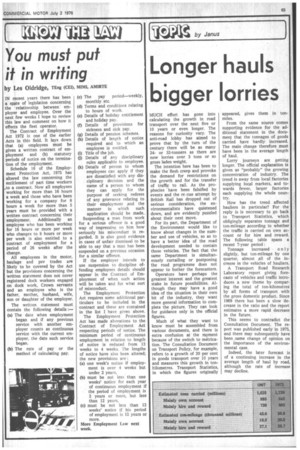You must put
Page 65

If you've noticed an error in this article please click here to report it so we can fix it.
• t • • t•
m wn mg
by Les Oldridge, TEng (CEI), MIMI, AMIRTE
IN recent years there has been a spate of legislation concerning the relationship between employer and employee. Over the next few weeks I hope to review this law and comment on how it effects the fleet operator.
The Contract of Employment Act 1972 is one of the earlier Acts in this field. It lays down that (a) employees must be given a written contract of employment and (b) statutory periods of notice on the termination of the employment.
Schedule 16 of the Employment Protection Act, 1975 has altered the law concerning the entitlement of part time workers ,to a contract. Now all employees working for more than 16 hours a week and those who have been working for a company for 8 hours a week for more than 5 years must be provided with a written contract concerning their employment. Additionally an employee who has been working for 16 hours or more per week who changes to 8 hours or more per week is also entitled to a contract of employment for a period of 26 weeks after the change.
All employees in the motor, haulage and psv trades are likely to be covered by the Act but the provisions concerning the written statement does not cover registered dock workers engaged on dock work, Crown servants and an employee who is the father, mother, husband, wife, son or daughter of the employer.
The written statement must contain the following details :— (a) The date when employment began and if any previous service with another employer counts as continuous service with the current employer, the date such service began.
(b) The rate of pay or the method of calculating pay. (c) The pay period—weekly, monthly etc.
(d) Terms and conditions relating to hours of work.
(e) Details of holiday entitlement and holiday pay.
(f) Details of provisions for sickness and sick pay.
(g) Details of pension schemes.
(h) Details of length of notice required and to which an employee is entitled.
Title of the job.
(1) Details of any disciplinary rules applicable to employee.
(k) Details of person to whom employees can apply if they are dissatisfied with any disciplinary decision and the name of a person to whom they can apply for the purpose of seeking redress of any grievance relating to their employment and the manner in which such application should be made..
Suspending a man from work for a serious offence is a good way of impressing on him how seriously his misconduct is re garded. It is also good evidence in cases of unfair dismissal to be able to say that a m,an has been suspended on a previous occasion for a similar offence.
If the employer intends to use suspension to discipline offending employees details should appear in the Contract of Employment of when such action will be taken and for what sort of misconduct.
The Employment Protection Act requires some additional particulars to be included in the contract and these are contained in the list I have given above.
The Employment Protection Act has made alterations to the Contract of Employment Act respecting periods of notice. The minimum period of continuous employment in relation to length of notice is reduced from 13 weeks to 4 weeks. The lengths of notice have also been altered; the new provisions are : (a) one week's notice if employment is over 4 weeks but under 2 years, (b) must be not less than one weeks' notice for each year of continuous employment if the period of employment is 2 years or more, but less than 12 years, (c) must be not less than 12 weeks' notice if his period of employment is 12 years or more.
More Employment Law next week.




































































































































